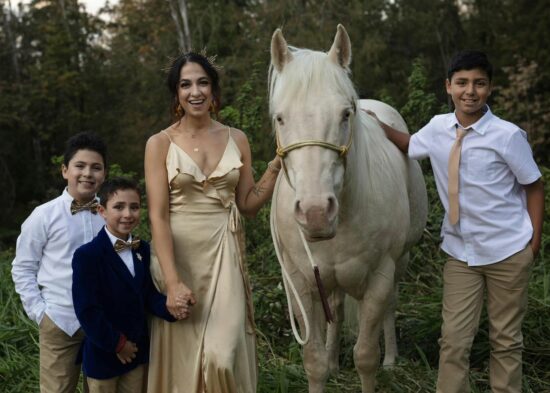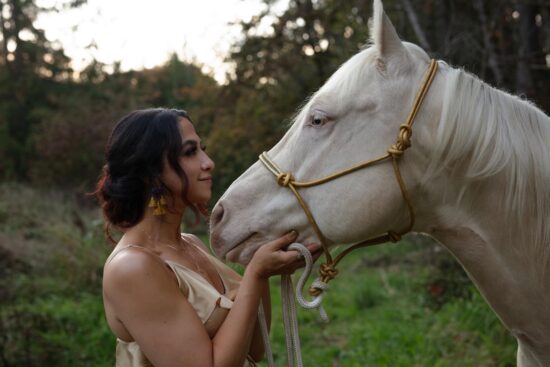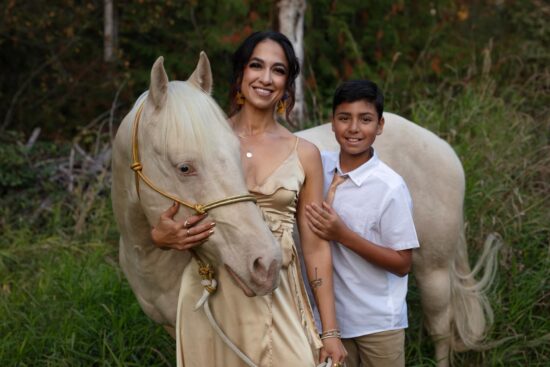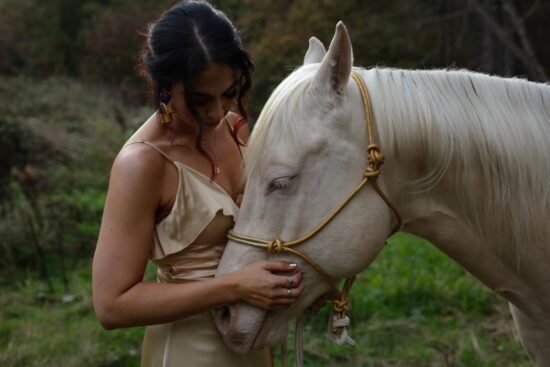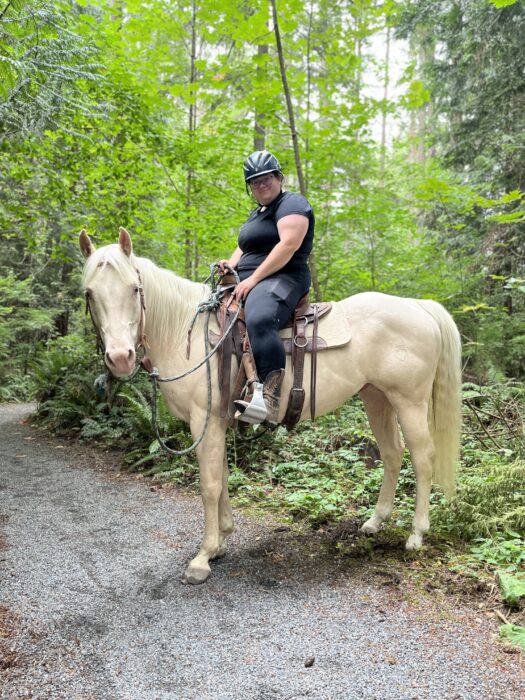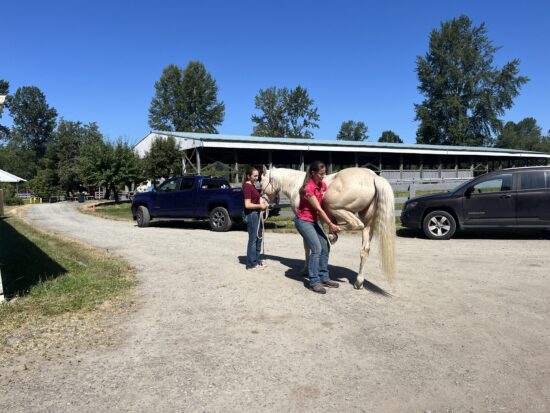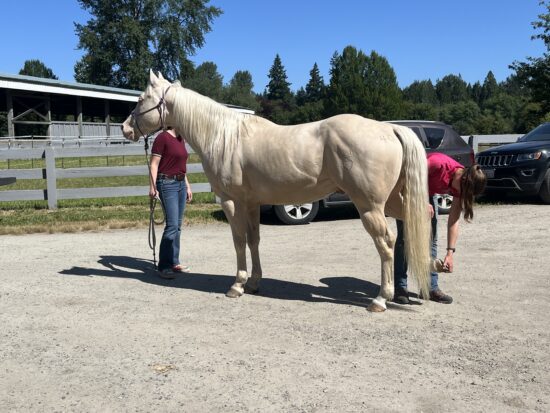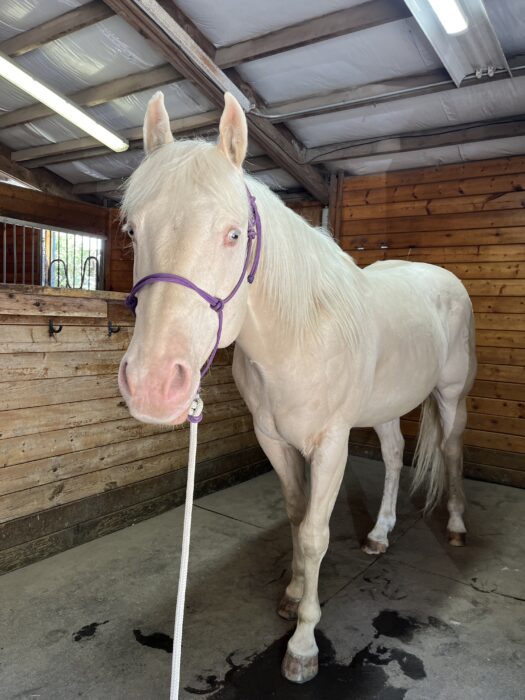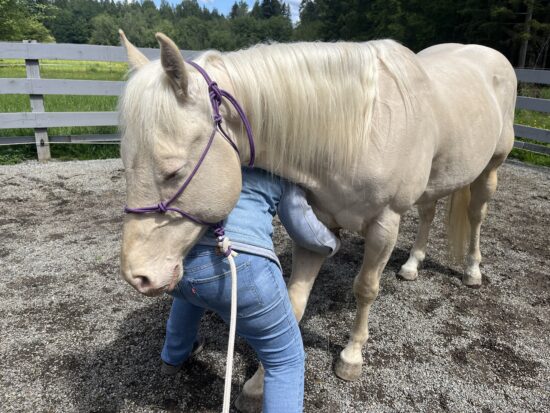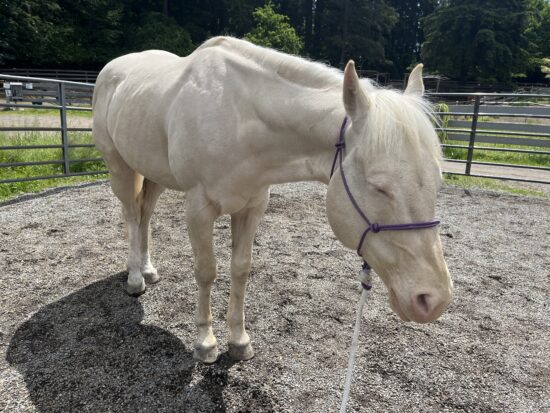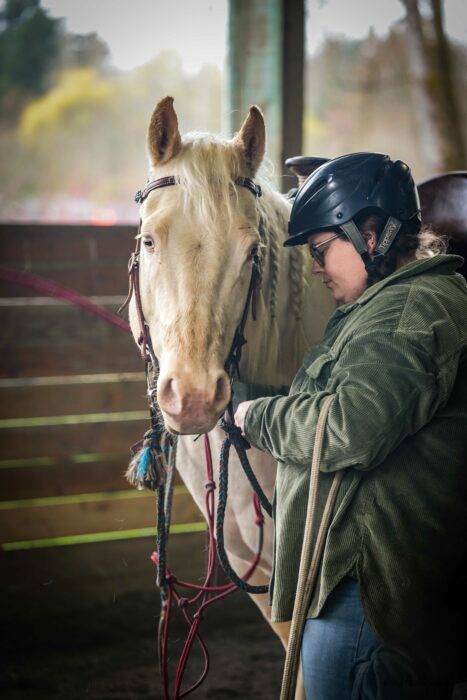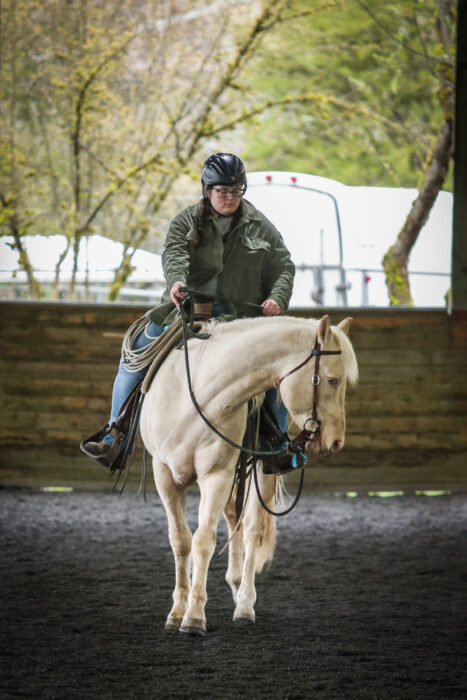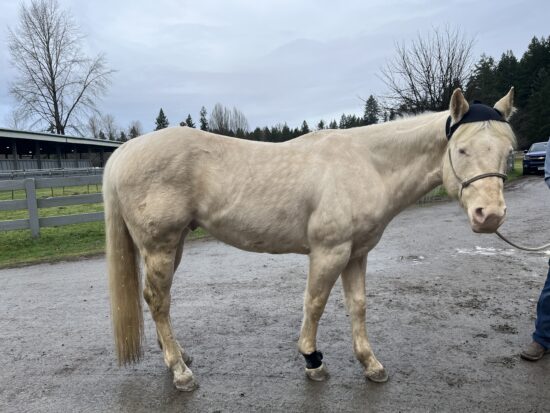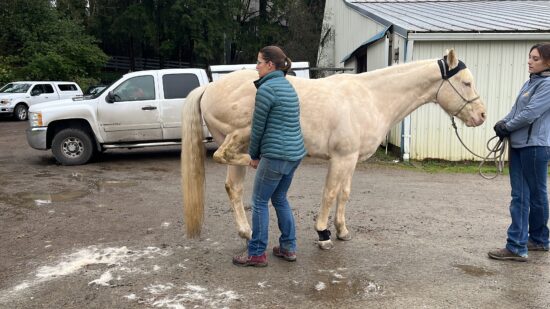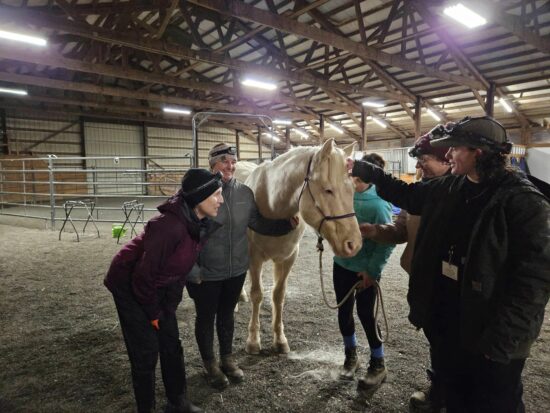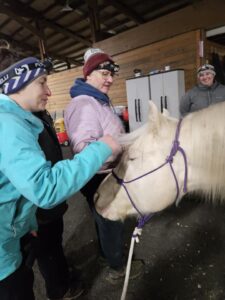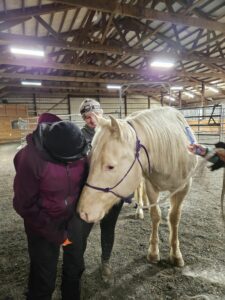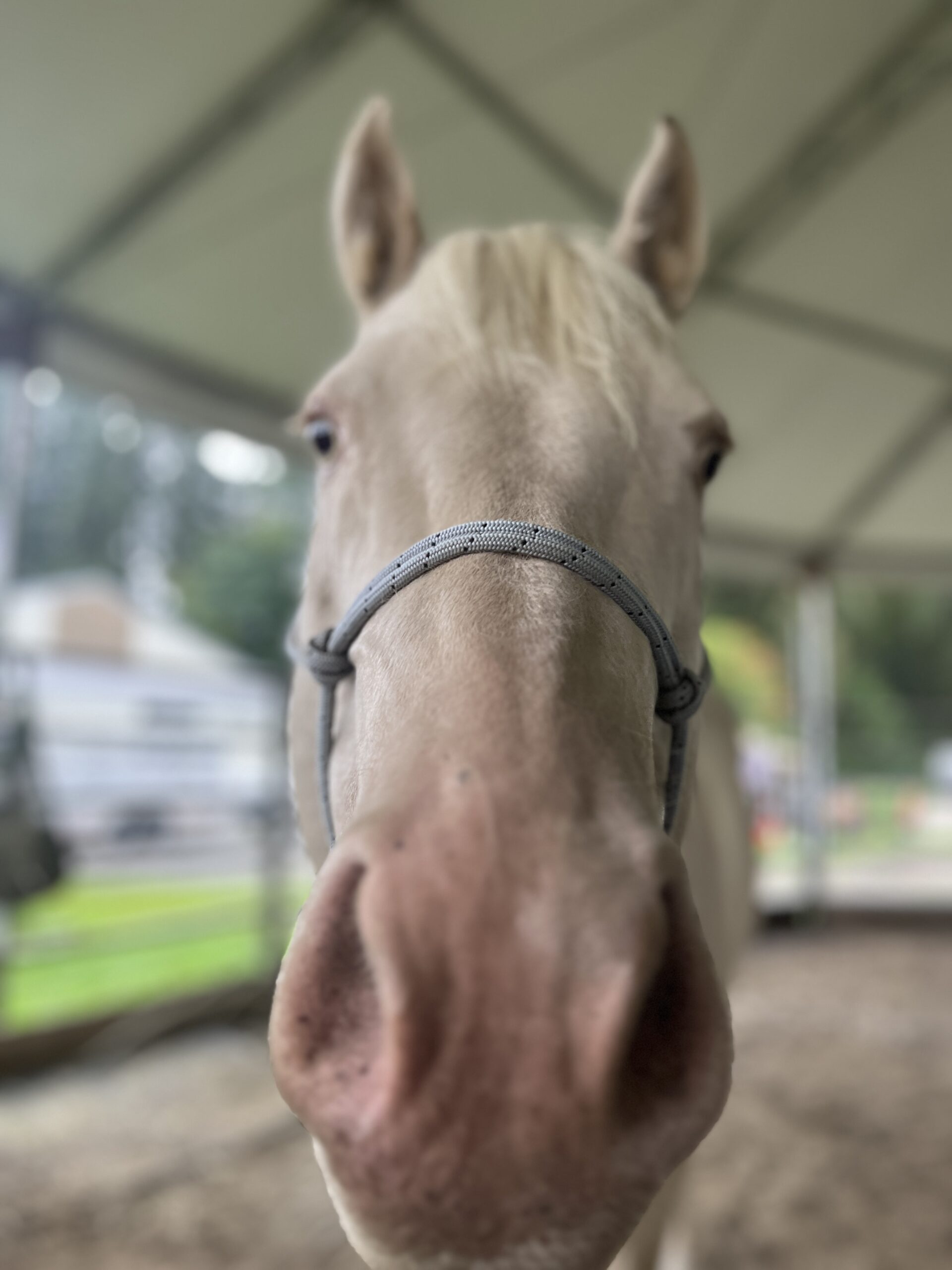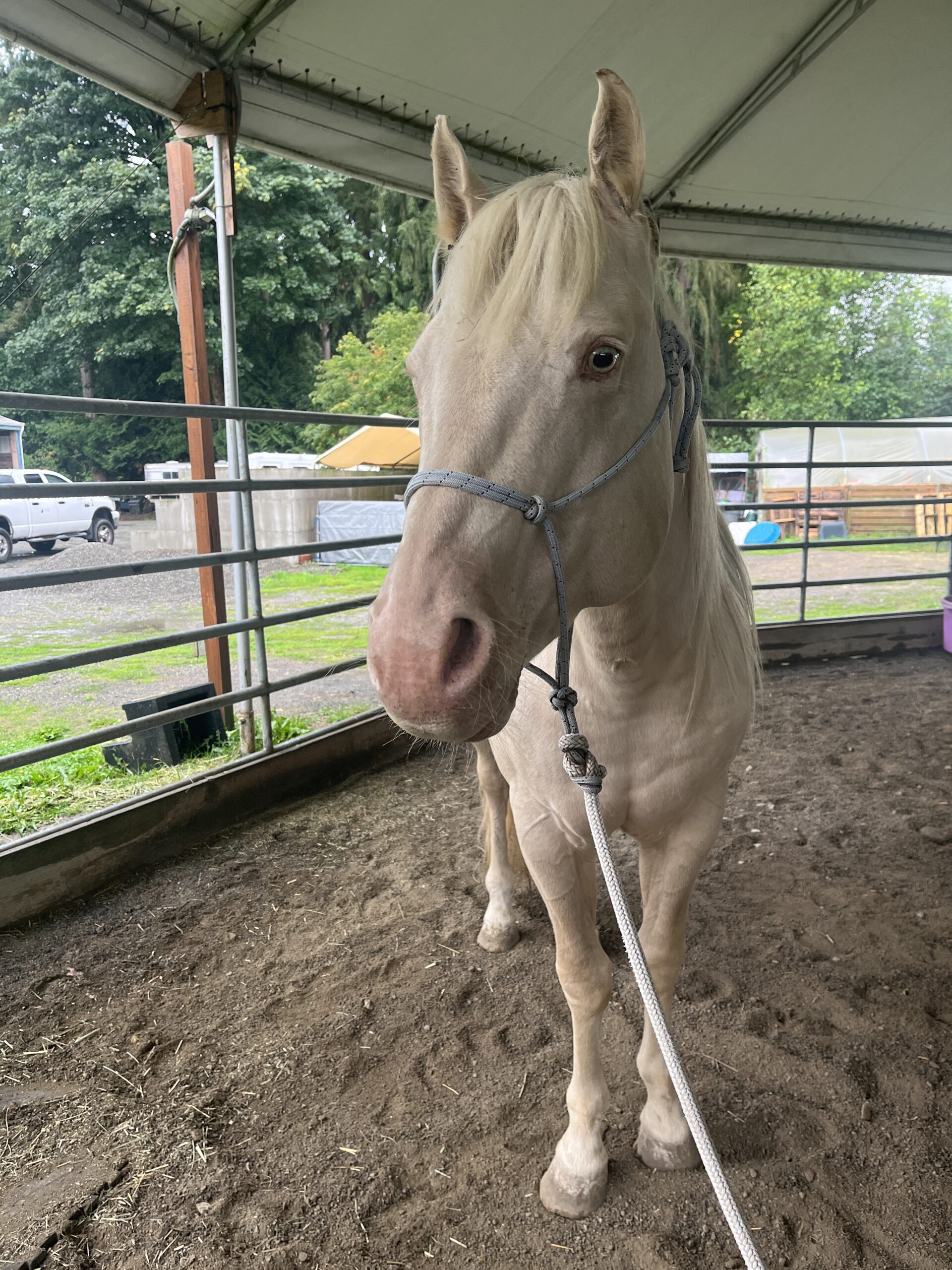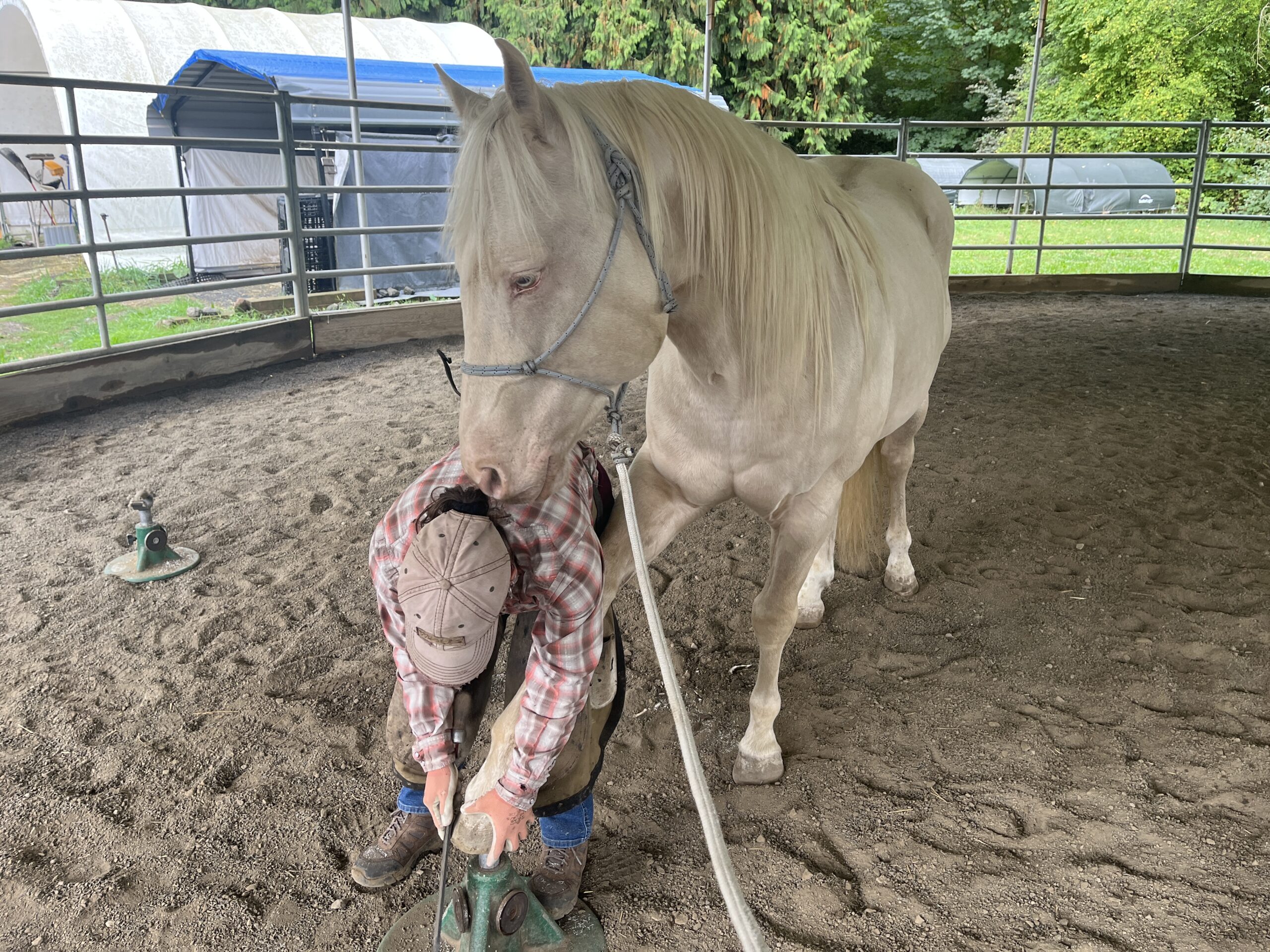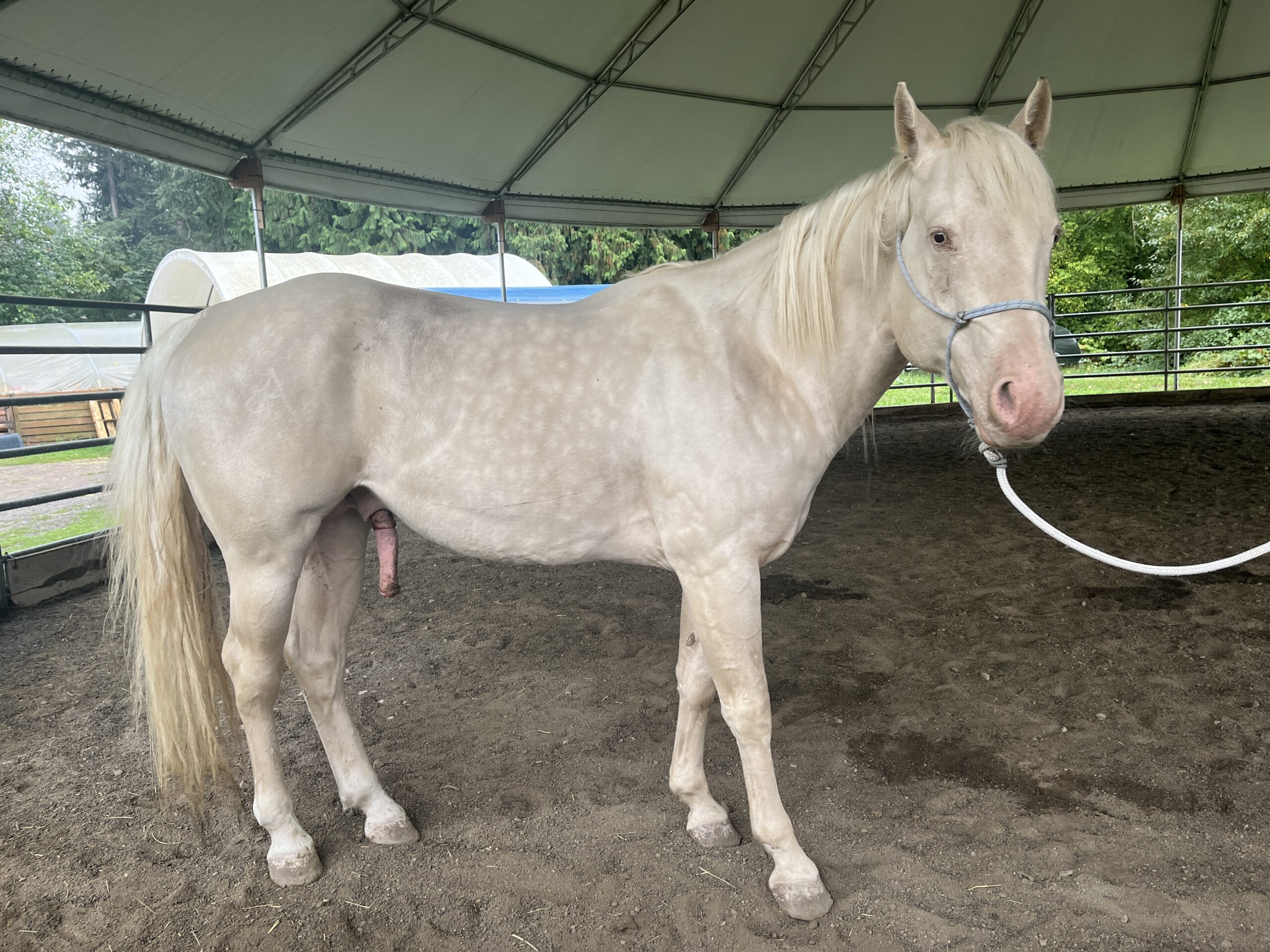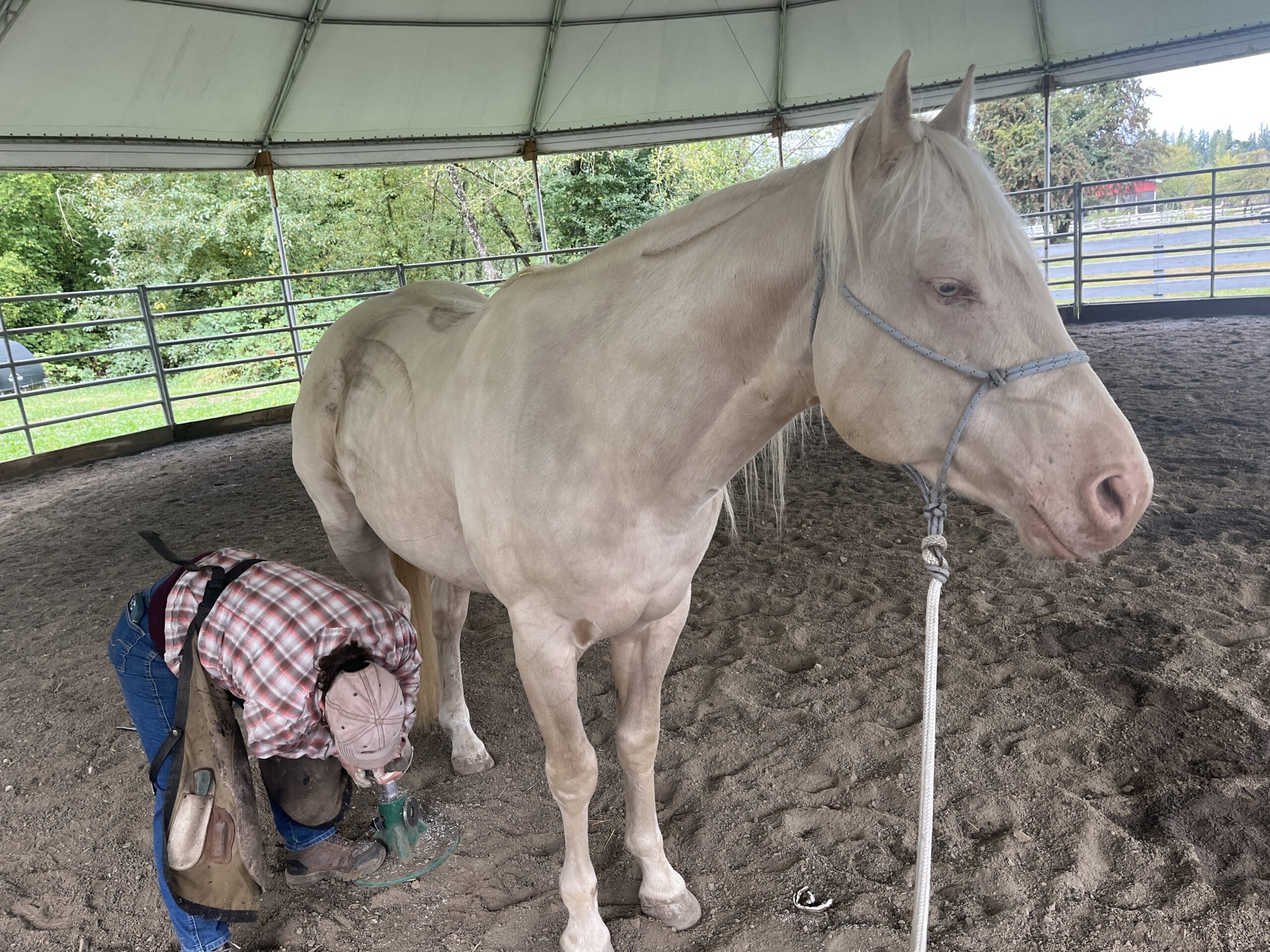Jupiter
2017 Cremello Appendix Quarter Horse Gelding
Registered Name: Mi Ways Hustling
Type of Rescue: Animal Control Seizure
Intake Date: 9/23/2023
Adoption Date: 11/27/2024
Length of Time with SAFE: 1 year, 2 months
ADOPTED!! by Marissa D
Jupiter came under SAFE’s care back in December of 2022 as part of an Animal Control seizure. He lived for the majority of 2023 at a foster location, but came to SAFE at the end of the summer. He was still a stallion then, but was shortly thereafter made into a gelding. Jupiter had been started under saddle in his earlier years, and his restart at SAFE went smoothly.
Jupiter had a sore back, which we worked on troubleshooting during his time at SAFE — putting him in shoes, working on the best saddle fit, and strengthening his muscles all helped to resolve this issue. In late 2024, Jupiter was adopted by Marissa, who had been coming out to work and ride him for months. Congratulations, Jupiter!
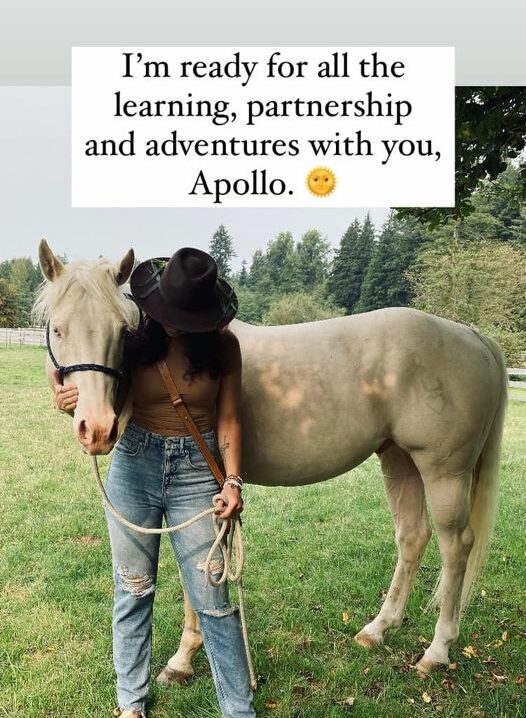
Alumni Update: Jupiter (Apollo)
From Jupiter’s adopter, Marissa:
Adoption Day! So, so, so incredibly grateful for every single SAFE member who poured their time, energy and love into Jupiter, now known as Apollo. He is amazing, and that is because of you!!
This journey has begun.
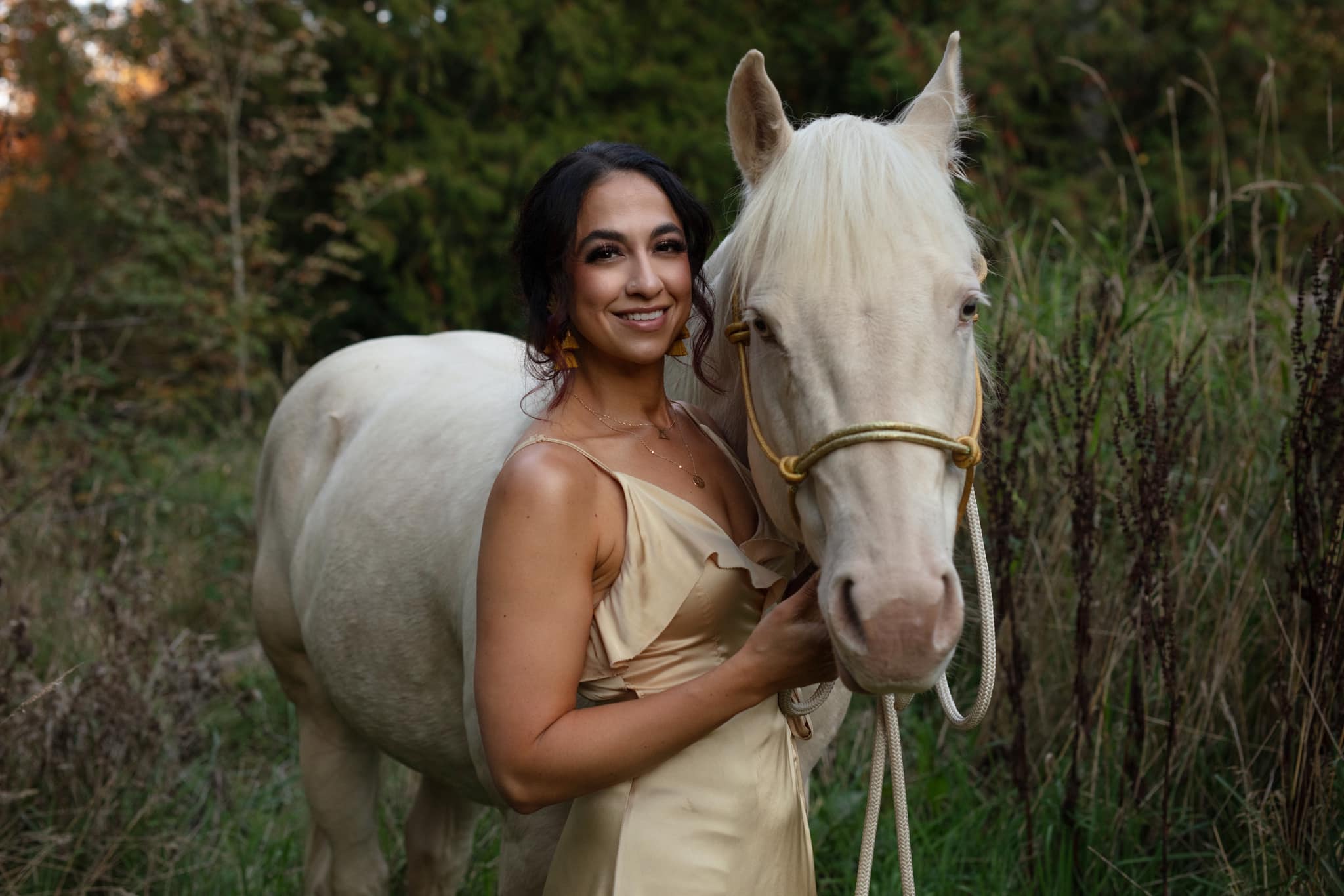
Jupiter is Adopted!
Jupiter has been adopted!
Jupiter’s story is one of patience. After arriving at SAFE, being gelded and restarted under saddle, Jupiter had quite a bit of interest. A handsome cremello with a kind personality, what’s not to love? But some soundness issues cropped up, and later, a sore back. There was quite a bit of troubleshooting and rehabbing we would have to do before sending this dude off to his forever home.
During it all, Marissa, who had first seen and fallen for Jupiter at a Storytime with the Ponies event, stuck by his side. She came out to visit with him many times over the course of many months, helping him with his carrot stretches and taking him for hand walks when he was on a break from riding. When he was sound and riding fit again, she took lessons on him at SAFE with her trainer to ensure that it was a good fit. The two spent many hours here together, from going on trail walks to grooming sessions, and when it was finally time to take him home, she worked very hard at finding the perfect place to house the newest addition to her family.
Jupiter, now called Apollo, has such a bright future ahead of him, and we are so excited for him! So far, he has been a calm, relaxed guy at his new barn and is getting along well with the other horses. He also makes a very handsome model, if we do say so ourselves.
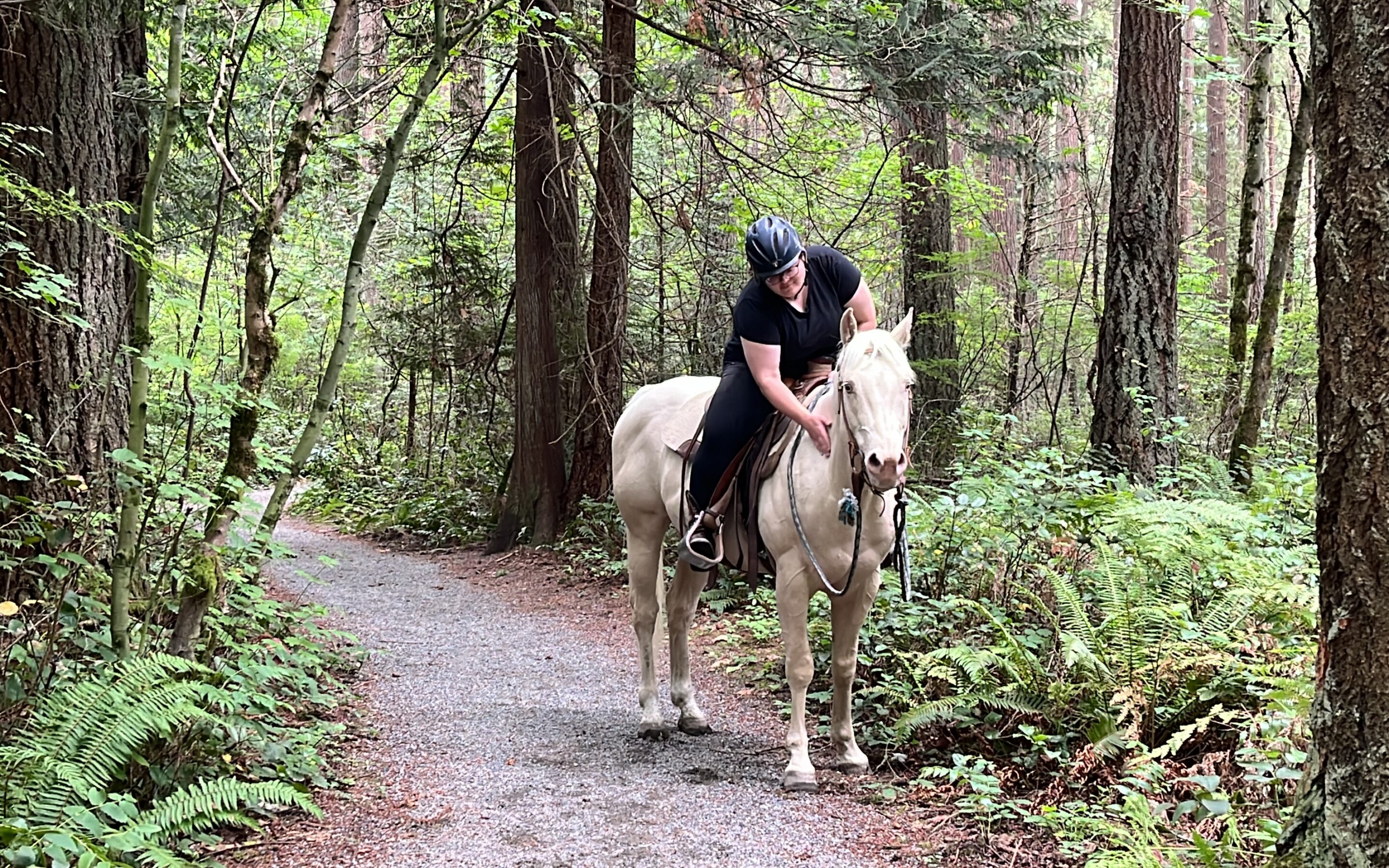
Jupiter Out on the Trails
Jupiter, brave Jupiter, recently hit the trails to showcase how all his hard work in the arena has paid off.
This guy didn’t miss a stride on his recent trail walk, taking up the lead with the calm cool collected attitude of a seasoned pro. True, it wasn’t exactly his first time on the trail, having seen it for the first time on a hand walk a few weeks prior, but to walk alongside and to walk underneath are two separate asks, and he handled both with grace.
Past Farrel-McWhirter’s funny farm, the playground with swinging, screaming children, and some well-meaning pedestrians who tucked themselves into the shadows (for those of you hikers sharing the trail with horses, it is always the safest option to announce your presence), Jupiter stayed solidly focused on the task at hand: carrying his rider where she asked, and even posing for a photo or two along the way.
We think the outdoors agree with you, Jupiter!
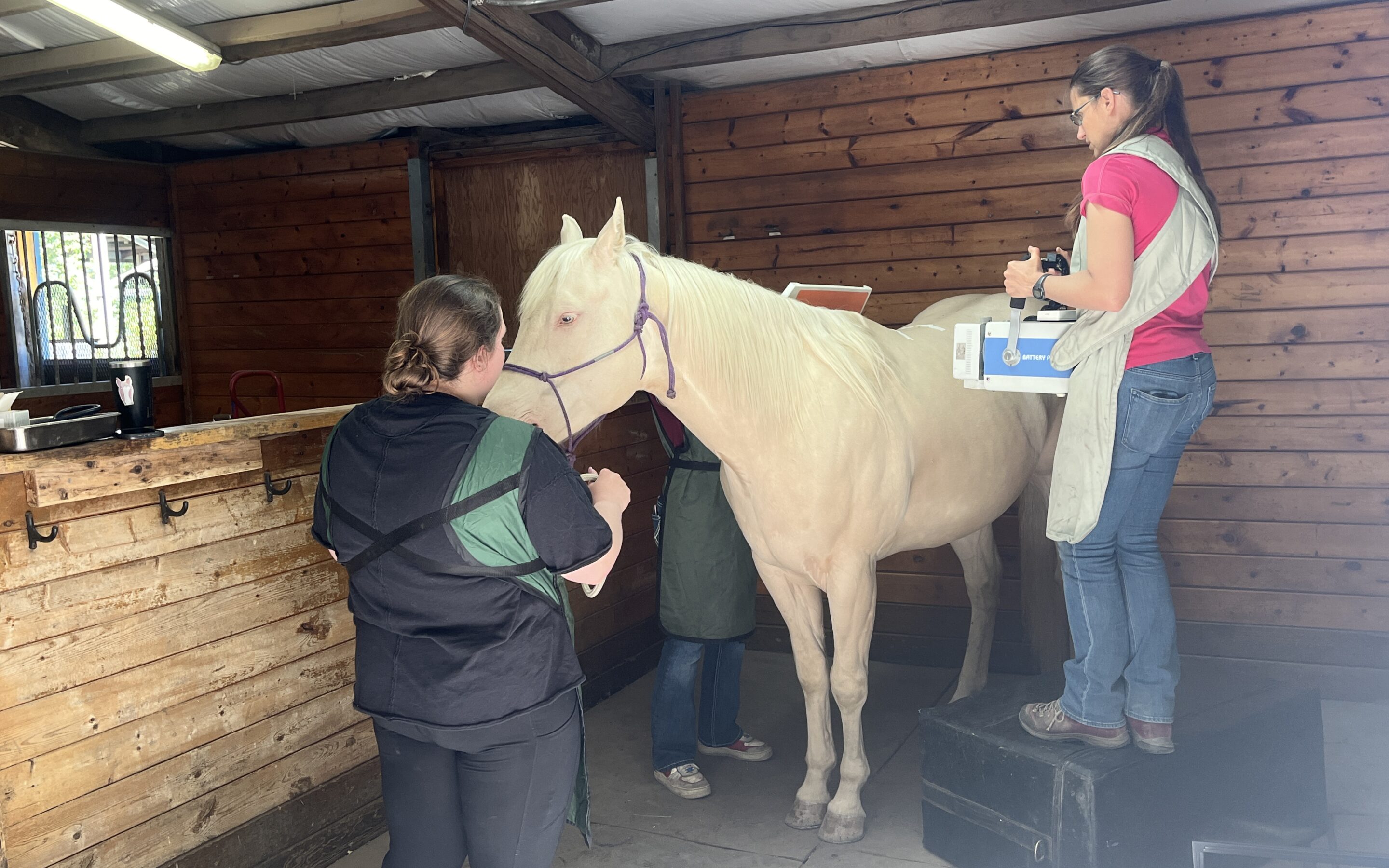
Jupiter’s Back
Do you want the good news or the bad news first?
The good news is that at a recent lameness check back in early June, Jupiter was the soundest he’s ever been. Putting him on Equioxx, tacking on some front shoes, and legging him up has proven to be a tried and true regime for improving his soundness.
The “bad news” is that at that same lameness eval, while his movement looked great, palpation of his back revealed high sensitivity. We put him on methocarbamol, a muscle relaxer, to help ease some of his pain, and gave him some time off from ridden work, opting instead to do strengthening exercises like trot poles and carrot stretches. We also measured him for a better saddle fit, suspecting that was part of, if not the main, issue.
But after several weeks of this abbreviated work, rest, and rehab, he was still quite sore. We had the vet out again for another recheck and to x‑ray his back in the event that something under the hood was causing him distress. His back x‑rayed clean – no evidence of kissing spines or anything else that would point to a sore back — which is, of course a good thing, but still begs the question as to if not that, then what?
The vet felt that there was a chance that the slight mild positives in his hind limbs (post-flexions) could be related to the pain as well, perhaps the back compensating for something happening in the limbs.
She also made note that his back sensitivity, while not gone, was mildly improved after the movement that accompanies a lameness exam. Because of this, our new plan for rehabbing would be to test his back, work him unsaddled, test his back again, and saddle him if there was not increased sensitivity. Making sure, of course, that if he did exhibit any increased tenderness that we would walk it back. If he was still off after our new rehab plan, the next step would be to take him off the Equioxx and see if we couldn’t exacerbate that lameness to better pinpoint where specifically it was stemming from.
Jupiter also met with Dr. Rathbone for a round of acupuncture, the results of which were immediate and marked relief. Since his appointment, his daily checks for soreness have shown an almost night and day difference from only a few weeks ago, when even a light touch would cause him to flinch.
Jupiter has also been treated to several rounds of pulsed electromagnetic field (PEMF) therapy which has also shown a significant difference in his comfort.
The changes so far since his vet check have been significant and reassuring, and we can only hope that they continue as he gets back into the full swing of things!
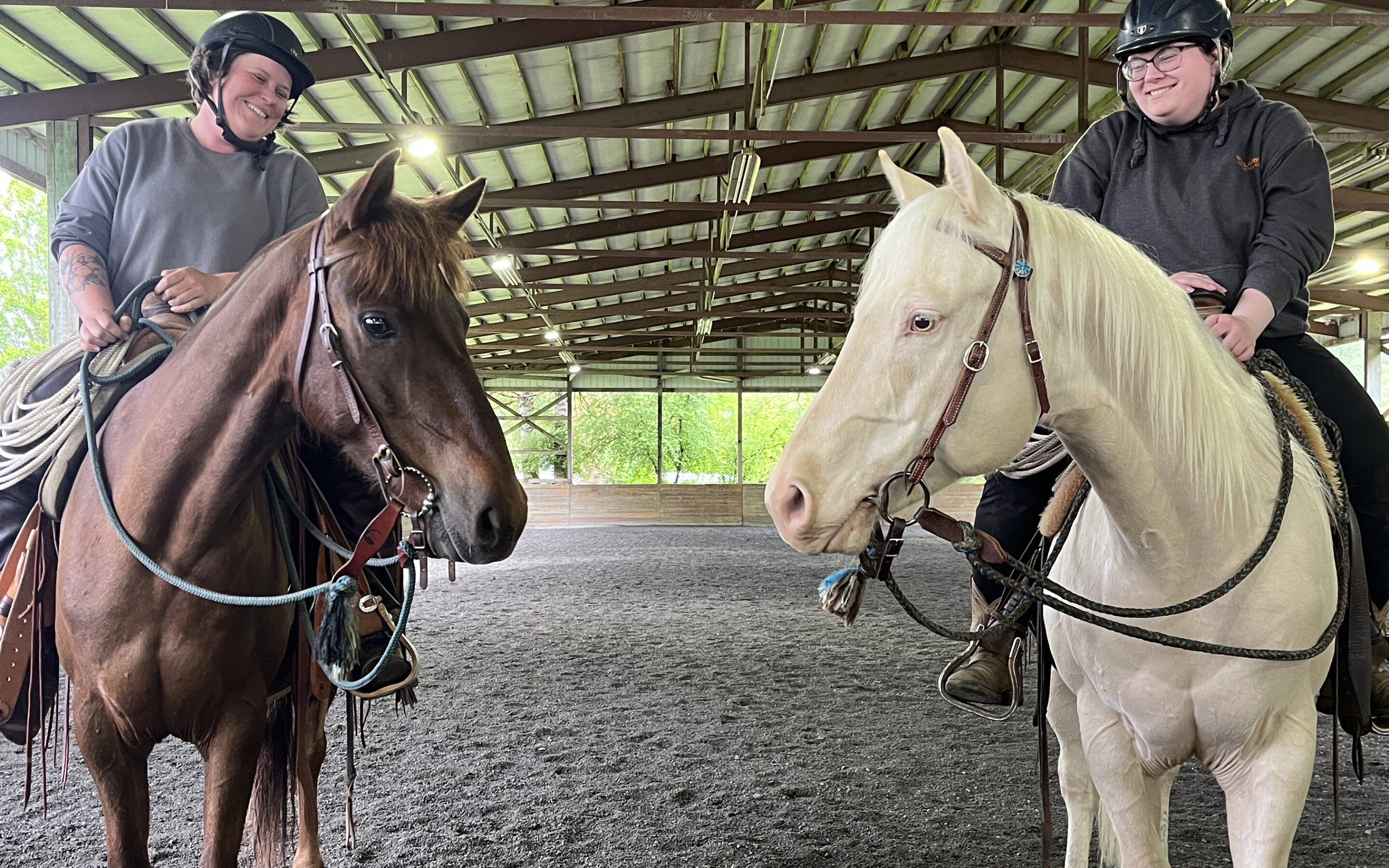
SAFE at Buck
Buck Brannaman is headed to Washington for the next two weekends, and the SAFE horses will be joining him at his clinics in Spanaway and Ellensburg. This is a great opportunity for the horses to get experience off-property while furthering their education with a phenomenal horseman.
Come see:
Esme, 2015 Yakima Reservation mare, at Spanaway and Ellensburg
Jupiter, 2017 AQHA gelding, at Spanaway and Ellensburg
Edward, 2014 Yakima Reservation gelding, at Spanaway and Ellensburg
Veronica, 2015 Yakima Reservation mare, at Spanaway
Moshi, 2016 pony mare, at Spanaway
Barb, 2019 Yakima Reservation mare, at Ellensburg
Artie, 2013 Yakima Reservation gelding, at Ellensburg
Tiva, 2011 Yakima Reservation mare, at Ellensburg
Auditors welcome, $30/day
Spanaway dates are June 21–23 at the Tacoma Unit, Horsemanship 1 from 9–12 & Horsemanship 1.5 from 1:30–4:30
Ellensburg dates are June 28–30 at the Rodeo Grounds of the Kittitas Event Center, Foundations from 9–12 & Horsemanship 1 from 1:30–4:30
You can find out more information on Buck’s site: https://brannaman.com/bb-clinic-si.html
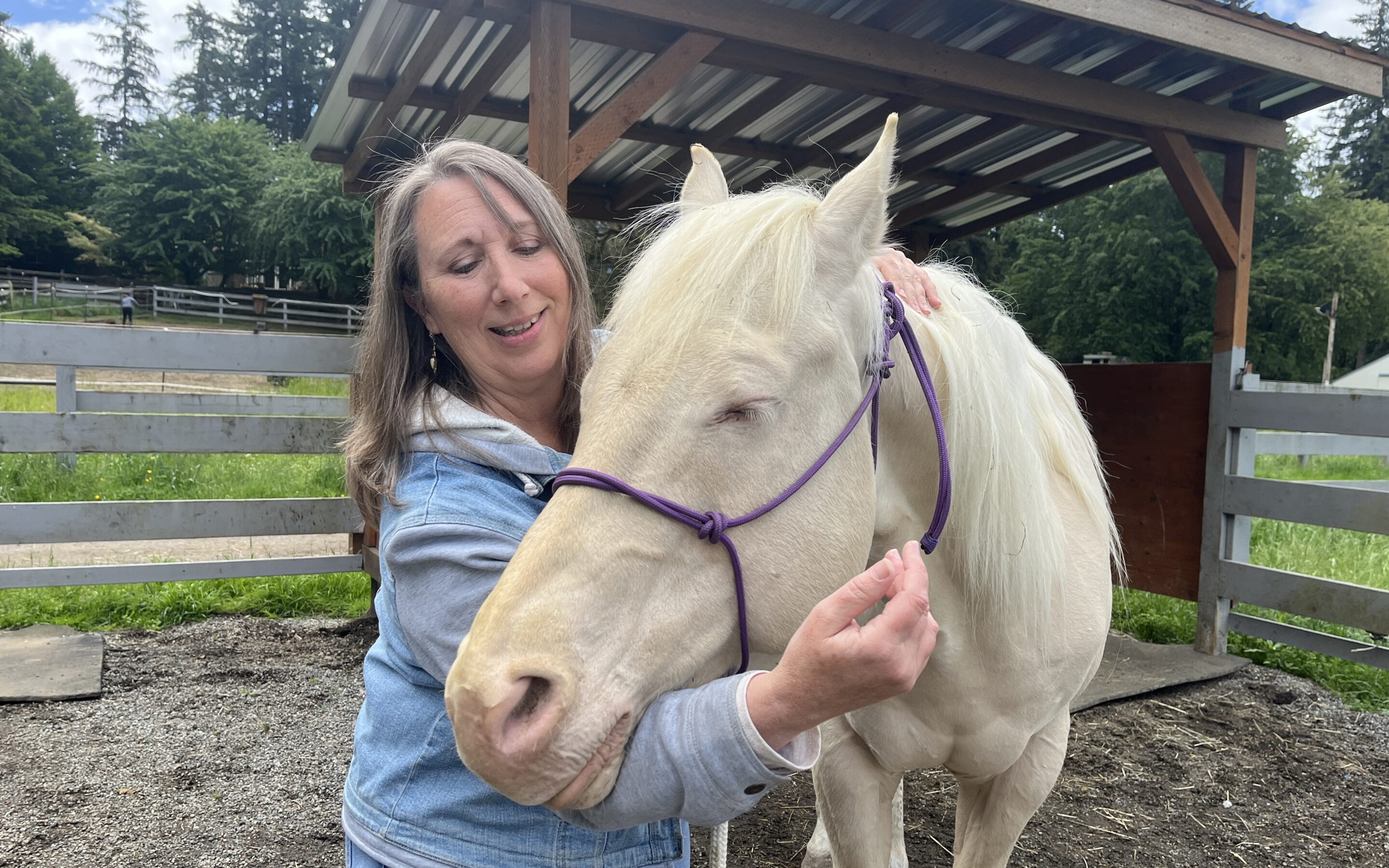
Jupiter’s Masterson Session
- Post-session — mellow guy!
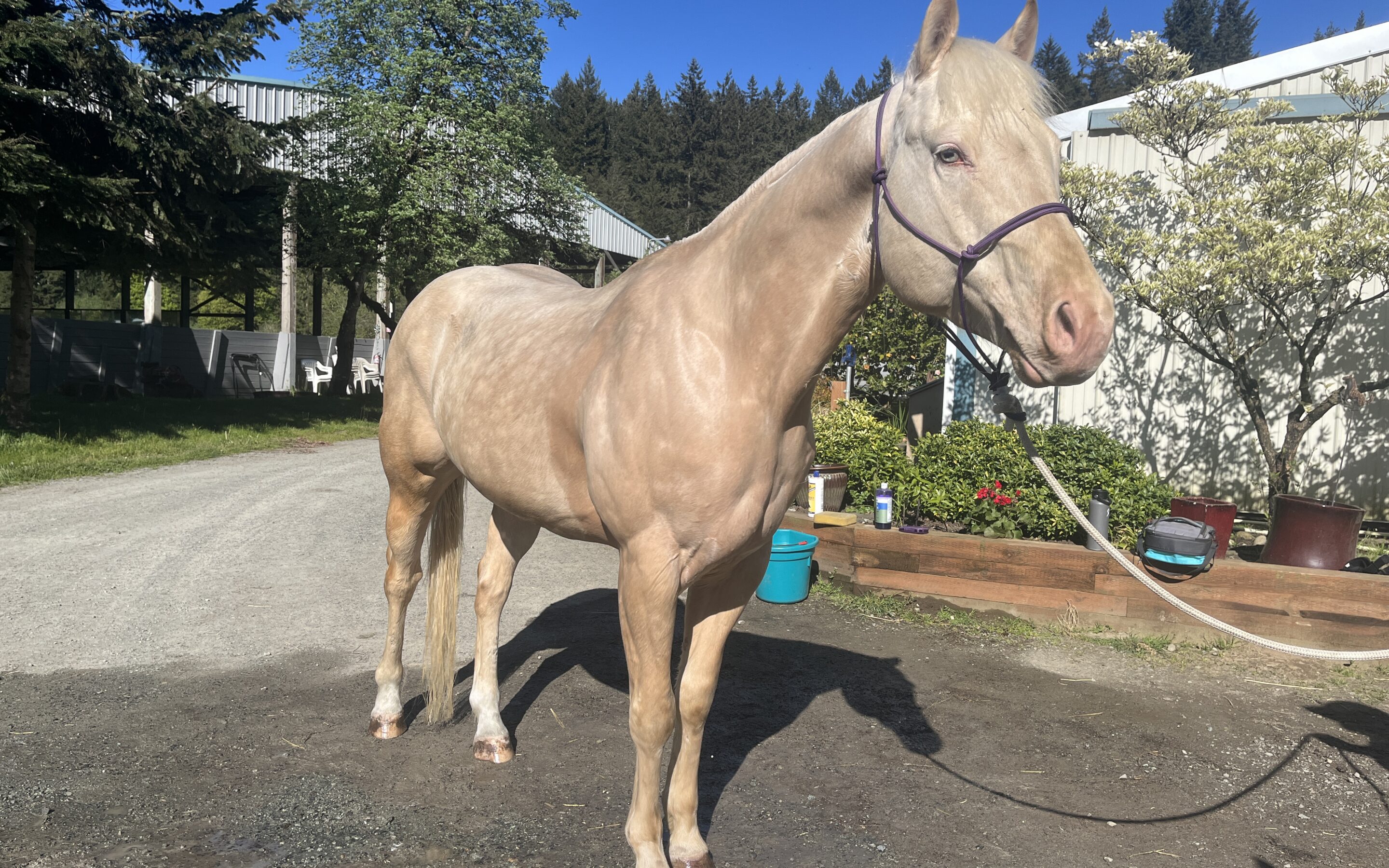
Orbiting Planet Jupiter
There’s an old adage that begins, ‘boys go to Jupiter…’ followed by a statement that implies it is where one goes to lose intelligence. Jupiter, the horse, is grounded enough to not take offense from such slanderous statements (and the fact that he does not understand English probably also helps), but we are here in his defense to express how much that little rhyme does not apply.
Jupiter is a very smart boy, and proves it consistently. He has been gaining more balance under saddle with each session, and has been testing the waters with different riders and their varied feels and doing well, overall. He still does not ‘fill in’ completely, and tends to shift back into ‘barrel mode’ if he senses a rider grow tight or fast in their body, but he has really slowed down — literally — from where he was when he first arrived. He can still be a lot of horse, but he has an arsenal of tools now to help his riders manage if he does get going a bit too much.
With a confident and more experienced rider, Jupiter really shines. Lexee, who has been riding him since his restart under saddle here at SAFE, has been helping him find balance and freedom in his feet, and as a result has been able to have great success with things like riding outside the round pen and having a rider flag off of him.
One thing is for sure, Jupiter is for sure getting more knowledge!
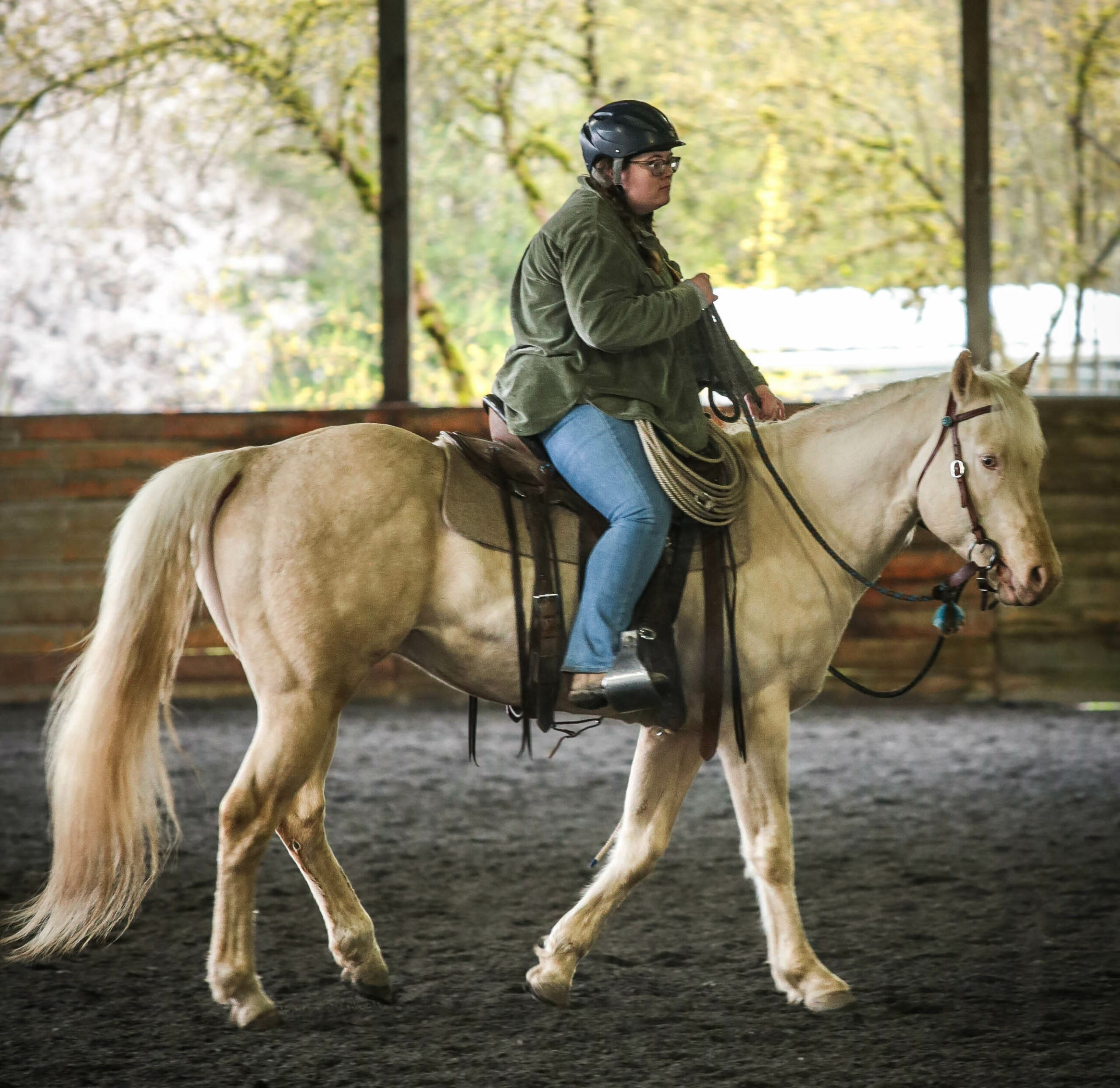
March Joel Conner Clinic Report: Jupiter
Lexee N has been working and riding Jupiter for several months, and recently brought him into the March Joel Conner clinic. Here’s what she has to say about this handsome guy:
“Jupiter is one of the sweetest, dopiest guys you could ever meet. And although his demeanor is what dreams are made of, his physical balance still needs quite a bit of work to keep him happy and comfortable. Jupiter like many quarter horses is built pretty downhill, with this comes with being heavy on the forehand. He has a hard time picking himself up and using his hind end to slow down. So this Joel clinic, the main goal was to find the best way to help instill more utilization of his hind end when he’s ridden. Asking him to drift his hind and work on hindquarters has been leading to some great changes to do this. Jupiter works hard and has a bright future once we can get through this sticky spot. Hopefully in the next 30 days we will see some big changes, making him much more ready for potential adoption.”
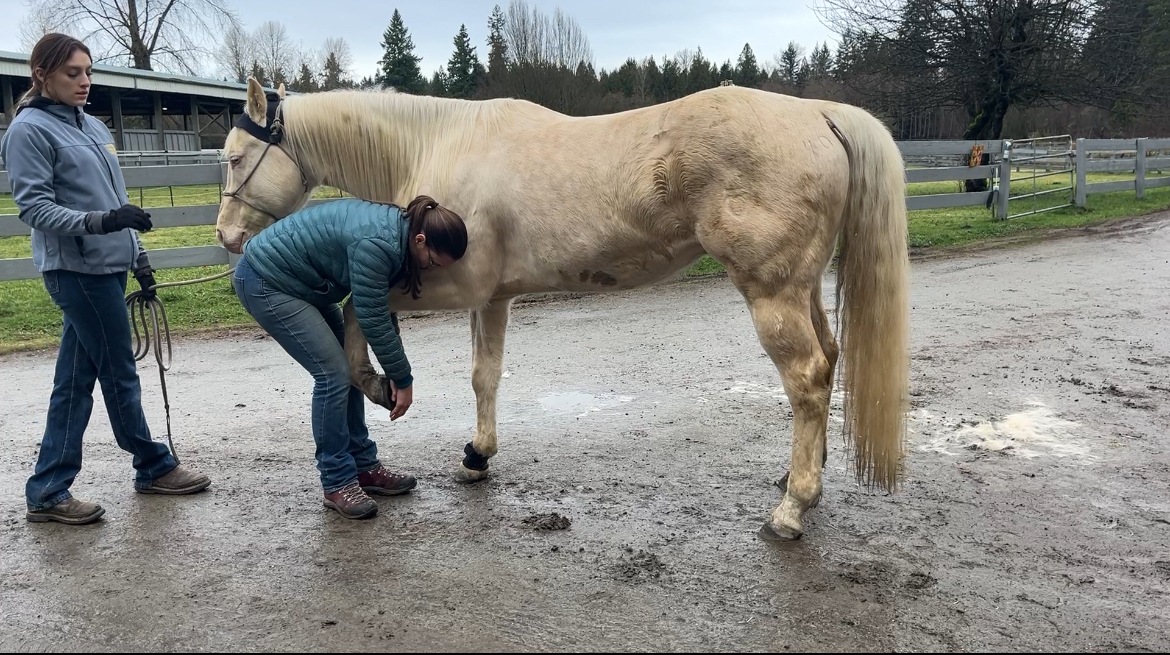
Jupiter’s Soundness Evaluation
Jupiter’s great red spot, as it were, is a slight hitch in his step that we first noticed when restarting him under saddle. In our efforts to better represent our riding horses as we move them into the ‘adoptable’ category, we had our vets out to evaluate Jupiter’s movement to give us a better idea of what he has going on, soundness-wise.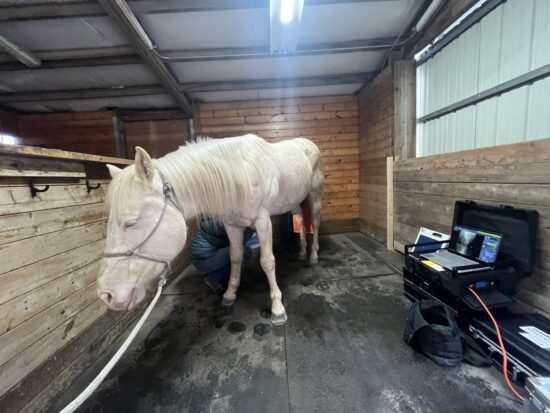
The long and short of it is, an initial assessment revealed that the source of Jupiter’s mild lameness stems from his hind end, particularly his right hind. We did shoot radiographs of both his right hock and right stifle, as those were where he flexed slightly positive, but no abnormalities were noted on the X‑rays. The gameplan our vets set us up with was to try him on Equioxx to see if it might improve his mobility. And so far, so good! He has been on Equioxx for about a month now, and it does seem to be helping. As he was never tremendously unsound to begin with, the extra bit of medicinal padding is meant to keep him more comfortable during working sessions.
Below is a video of his motion on hard and soft ground before any treatment was started.
Additional routes of exploration would be to block the right hind to localize the source, but as he is comfortable now, we will see if he can maintain and consider delving deeper down the line.
Trotting on hard ground, there was some mild right hind lameness, on both the straightaways and on circles to the left and the right. Trotting on soft ground, results were much the same, with a mild front right lameness that was also present while circling to the left on hard ground. He also had some mild sensitivity to hoof testers, which might see him in shoes down the line.
Jupiter was a very good boy for the exam, and sure looked cute in that little lameness locator hat!
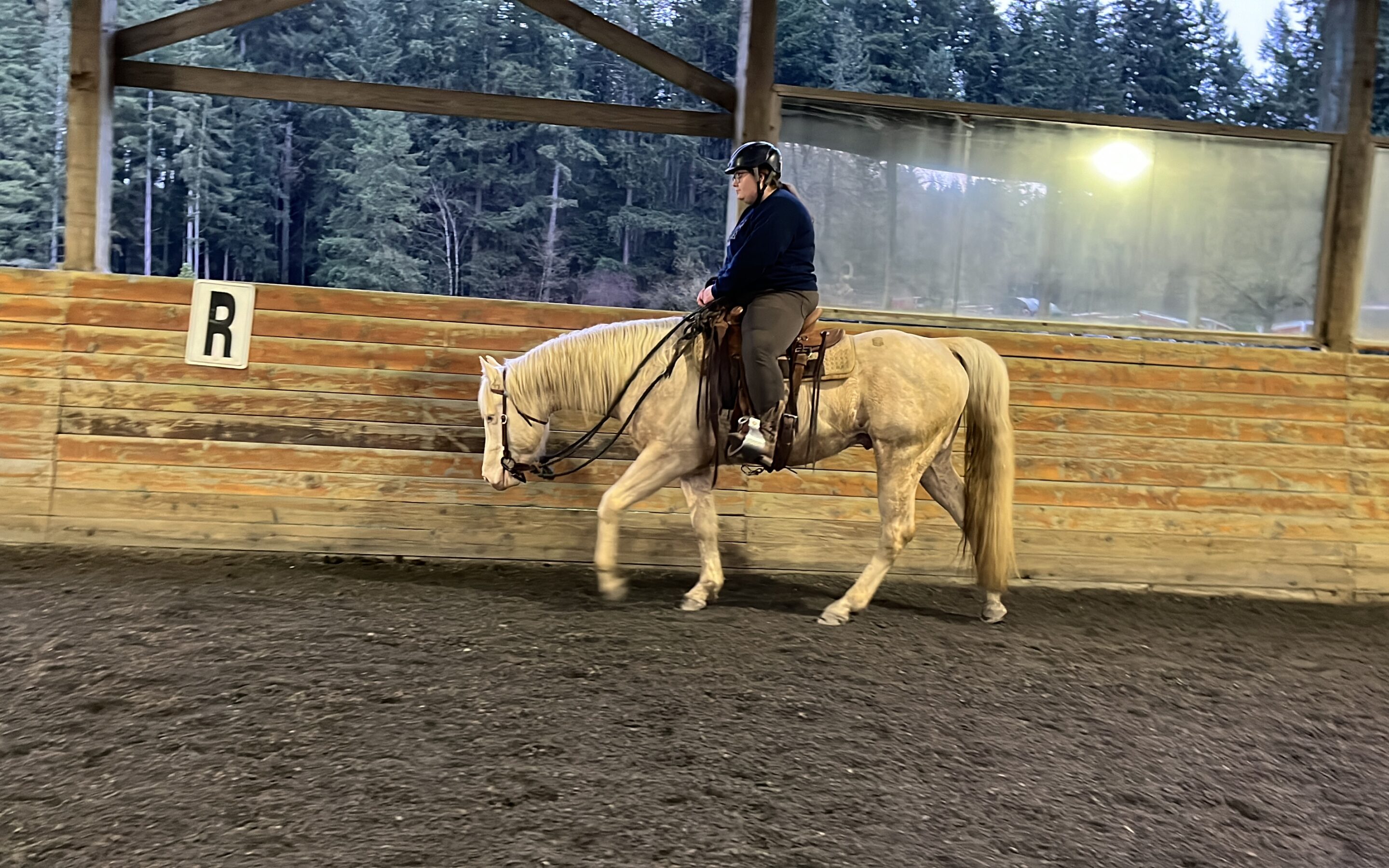
Jupiter in the Outdoor Arena
Jupiter falls under the somewhat rare category of horse we get in at SAFE, which is ‘previously ridden, relatively uncomplicated.’ Don’t get us wrong, there are ways in which Jupiter needs assistance both on the ground and under saddle, and there certainly exists a timeline in which he was not given as much support and therefore did not come along so quickly or so nicely, but Jupiter and SAFE have been a good match.
It is known to us that Jupiter ran barrels in his past, and has in him still the inclination to run a pattern when he gets going. He also has a tendency to be heavy on the forehand, so work is being done to help him set back and use his hind more. But even still, his first rides in the outdoor arena have gone tremendously well. Even without another horse around, his personality is such that he is able to find a lot of support from his rider, and from himself — he definitely leans more towards the confident and self-assured side of the spectrum.
Lexee has been helping him follow a feel, especially when it comes to bringing him down through the gaits. When he first started out, he had a very easy time going fast and gaining speed, but didn’t have as easy a time staying balanced and slowing down. He is making progress in this department, and you can see in the video below how Lexee is able to bring him down off her seat (and how easily he can pet down to a stop, even in a new environment!)
This handsome guy is just about ready to start meeting adopters, and something tells us he won’t be on the shelf for very long!
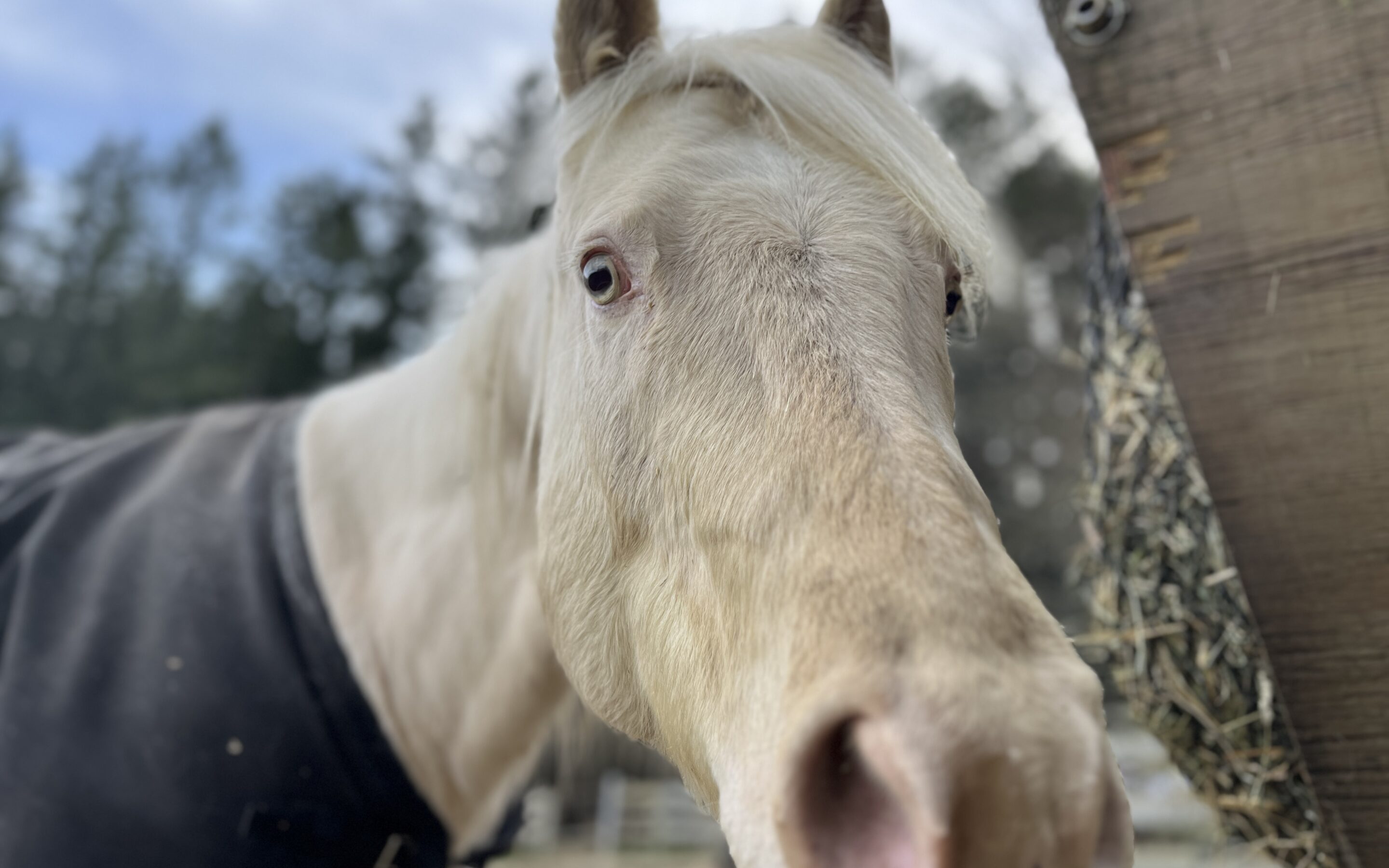
Sandy Jupiter
It seems an inevitability of horses and horse ownership (or stewardship) that there will come a time when your horse suffers from the most base of afflictions: a stomachache. We can talk about how cruel it is that the design of horses is such that their digestive system is a one-way road, no u‑turns allowed. The hard truth is, the issue must pass, or it will arrest them where they stand.
The last thing you want to hear is of a horse down during feeding time. While the sight of a thousand pound animal curled up in their stall or on the soft ground of their paddock is certainly a sweet one during appropriate moments, when it occurs around mealtimes it is only ever anxiety inducing, unintentionally weaponizing the same vulnerability we ooh and aww at during healthier times. Alarm bells ring as our vet’s phone line does the same, and why, tell me, do horses always choose the most inopportune moments to colic?
It was Jupiter who spiked our blood pressure most recently, lying down with hay still bulging in his net. His vitals were within normal range, indicating his pain level wasn’t extreme, but he was clearly uncomfortable. A call to our vets and a dose of banamine later, Jupiter was feeling much improved, scrounging around for hay scraps we might have missed when pulling his hay. It was headed into evening, so we set up our cameras to watch him throughout the night, a baby monitor for our 6‑year-old colicky babe.
He pooped — a great sign, and what our vets were waiting for before easing him back into food. We started with a small soupy mash, gentle on the stomach with the added benefit of additional water intake. But shortly after finishing this snack, he was down again. Not painfully so, no thrashing or rolling, but clearly not feeling so hot.
It is truly a blessing to have Bonnie living on site, for when we noticed this change in Jupiter remotely, she was just a phone call and a quick walk away from being able to check on him. She got him up and got him moving, spending a little time to monitor his symptoms for any negative changes. A sweet water later, and she tucked him back into his stall, where he spent the remainder of the evening quiet.
Our vets, in puzzling out what could be the cause of his upset, requested that we check for sand. The next morning, armed with a plastic baggie, we scooped up some of Jupiter’s manure, of which he had had more overnight. It was soft in consistency, another sign that things were definitely not all right under the hood. Running a sand test is quite simple: breaking up the manure and adding water to create a slurry, allowing the bag (some people use gloves) to hang at an angle so the sand can collect in one place. Density and all that. Sure enough, Jupiter’s test was positive — he ended up with around 1/4″ of sand at the corner of his bagged sample after a brief waiting period.
We have always run sand tests here at SAFE, typically alongside our quarterly (for some) and bi-annual (for everyone) fecals. But after Otto’s sand colic last year, we decided that we needed to buck up our sand treatment in order to prevent situations like his from occurring. Luckily, Otto was able to pass it (and went on to get adopted not too long after!) but law of statistics says that not every horse would be so lucky. Treating more regularly for sand would hopefully help to cut down on colics.
But even with the quarterly treatments, we were still seeing positive results. And in this case, positive is a negative. So at the beginning of 2024, we opted to treat our entire herd monthly for sand, a 7‑day course of psyllium pellets added to their daily supplements at the beginning of each month.
Jupiter was on day 2 of his treatment when he colicked. It didn’t quite seem fair, to try to get ahead of the problem and have it happen anyway. But getting ahead of the problem was, in part, what caused it in the first place. But stay with me, this is a good thing. Our vets told us that gastric upset can occur as sand starts moving through the system. Starting Jupiter on his monthly sand-rid could have triggered his minor colic. But while we hate seeing a horse in distress, a minor discomfort is much preferable to a major impaction down the line. In helping him to move the little bit of sand he had, we were able to prevent it from building into something much more severe.
Because he was continuing to pass manure, we kept refeeding him. Typically we refeed with mash, but in the case of sand, our vet recommended hay instead. Forage is perhaps the best way to move sand along, tag-teaming with the psyllium. For several days and nights, we continued to monitor him. There were a few more doses of banamine given when his discomfort returned (never more than that initial display of a quiet mid-meal or post-meal lie down), but he continued to show interest in eating and passed manure on a consistent basis. He got a double dose of psyllium, at least a sweet water a day, and many pets and kisses to speed along the healing process. Our Saturday PM chore team was especially instrumental in that last part — after being pulled from his stall for a little walk after he was showing some signs of upset, the team gathered round him for some pampering and well-wishes. Sure, banamine is great, but nothing beats the power of good old fashioned love!
We treated Jupiter for sand for a little over a week, still getting slight positive results each time we checked. But his most recent test came back negative, leaving him in the clear for the time being! Dealing with a colic is never fun, but there is always relief when you know there to be a light at the end of the tunnel. Jupiter has made a full recovery, and while we hope not to see him in the ‘clinic’ again anytime soon, was the absolute perfect patient!
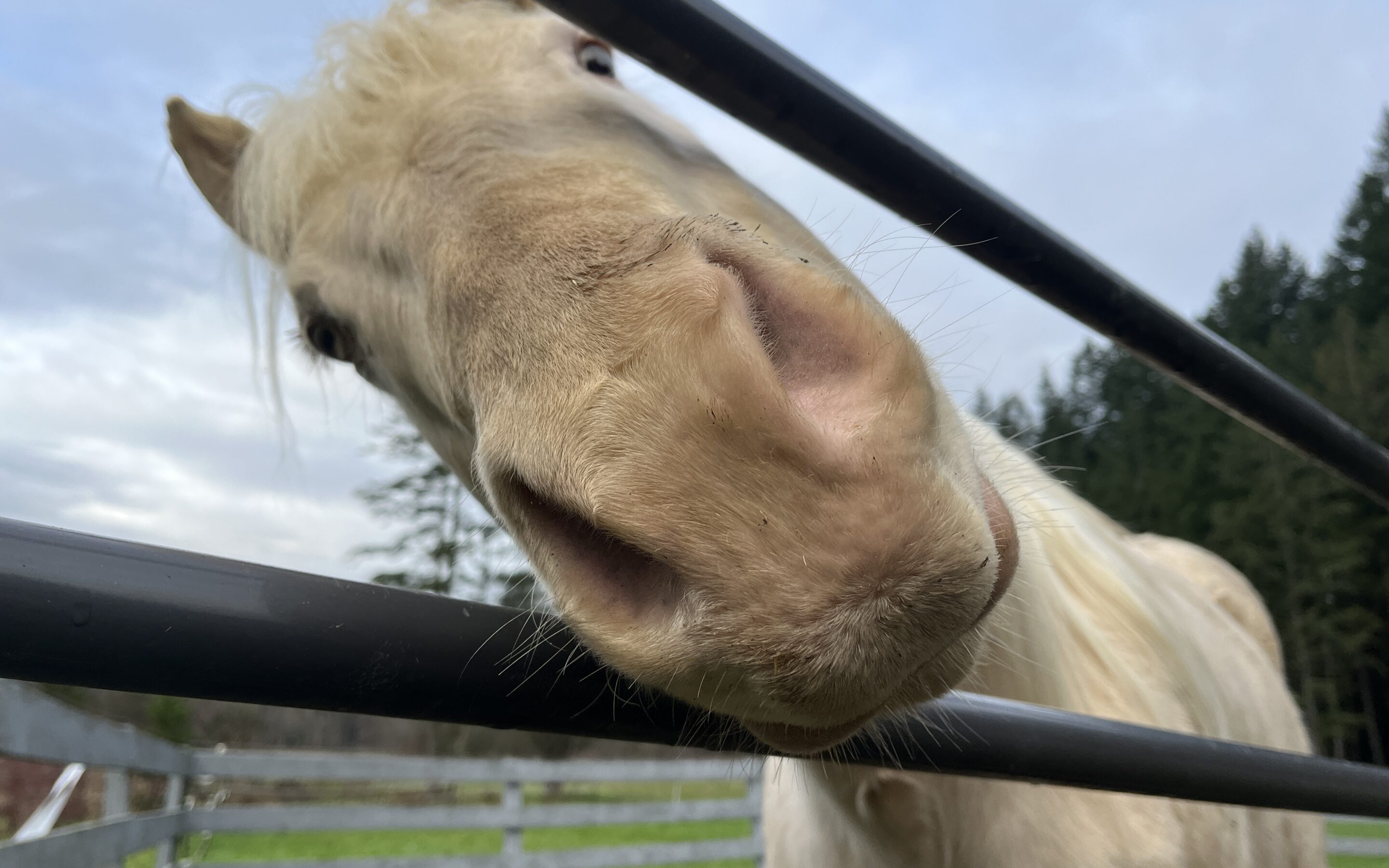
Training Update: Jupiter
Getting to know Jupiter has been a pleasurable experience. Beginning his training journey here was not starting from scratch — he had some experience being saddled and ridden in the past — and while that doesn’t always mean that things will be easy (often it means the opposite) it did give us some sort of foundation to build upon.
One of the first things we noticed about Jupiter was that on the ground he was quite ‘dull.’ Think accelerating in a Prius, when the ideal is something more akin to the feather-light gas pedal of a Ferrari. This is remedied by rewarding the try (to continue the metaphor, taking your foot off the gas pedal once the car does accelerate). Oh, if only my Prius could learn how to be more like a sports car! By asking Jupiter to yield his hind in a timely fashion or move up from the walk to the trot, and releasing him once he does so with a good amount of effort, Jupiter learns how to seek that release and becomes quicker to respond to the ask the next time. In the saddle, he has a bit of the opposite problem — he is too keen to move out, but in a mindless way that doesn’t take into consideration what his rider is asking of him. Through patience and continued practice, Jupiter is learning to understand a bit more day by day.
From Lexee N, who has been working and riding Jupiter for the last few months:
“He’s been great to ride. I’m working on having him feel of me and not try to perform a pattern (since he was trained on barrels in the past). He gets confused about the right answer, but he has a ton of try. We’ve been working on a nice slow lope and jog as he has been very rushed. But he is learning what a release means, and understanding there are new answers to the questions being asked of him.
On the ground he can still be pushy, but it’s clear he doesn’t have his heart in it. It will just take some extra time to get him life on the ground but luckily in the saddle he has remained lively.”
Here is a video of one of Jupiter’s more recent rides:
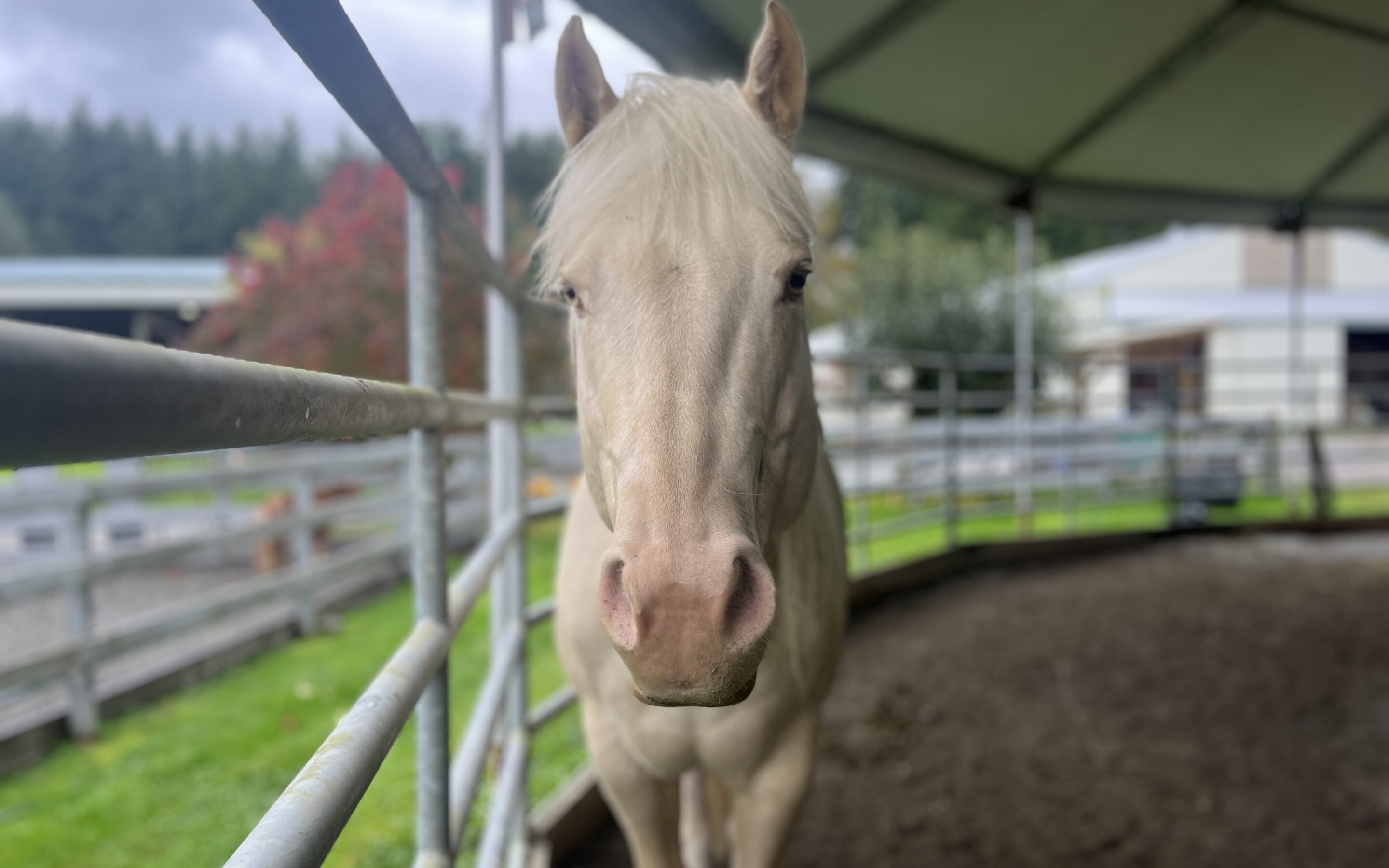
Say Hello to Jupiter
Animal Control seized Jupiter back in December of 2022, but his case was ongoing for so long that we were prevented from talking about him until very recently. He, much like the others who were a part of his seizure, was placed in a foster situation where SAFE supported him from afar. But when his foster reached out to us that she could no longer house him, we made plans to bring him here to the barn.
Jupiter arrived during a clinic weekend, arguably one of the busiest times at SAFE. He was a stallion then, and we braced ourselves for the ensuing drama that his arrival might bring. But as he stepped off the trailer and into the covered roundpen he’d call home for the next little while, he barely made a peep. This trend continued as, throughout the weekend, as horses came and went all around him, he was quiet as a mouse. In fact, we forgot that there was even a new horse on site to begin with, let alone a stallion.
Jupiter continued the trend we had seen this year of kind, easy-going stallions. He was a perfect gentleman for handling, and let us get his hooves trimmed just a few days after his arrival. He was polite on the ground, and decidedly not ‘studdy.’
We set an appointment for his gelding, and when that day arrived, Jupiter went under the needle and knife with the same ease he had thus far done everything else. His gelding was relatively uneventful, and he has since been healing without issue, getting his twice daily forced exercise and moving out like a pro. He was under saddle for a time before he came to SAFE, so as he continues healing, we are excited to get him into the flow of things and see where he is in his training.

